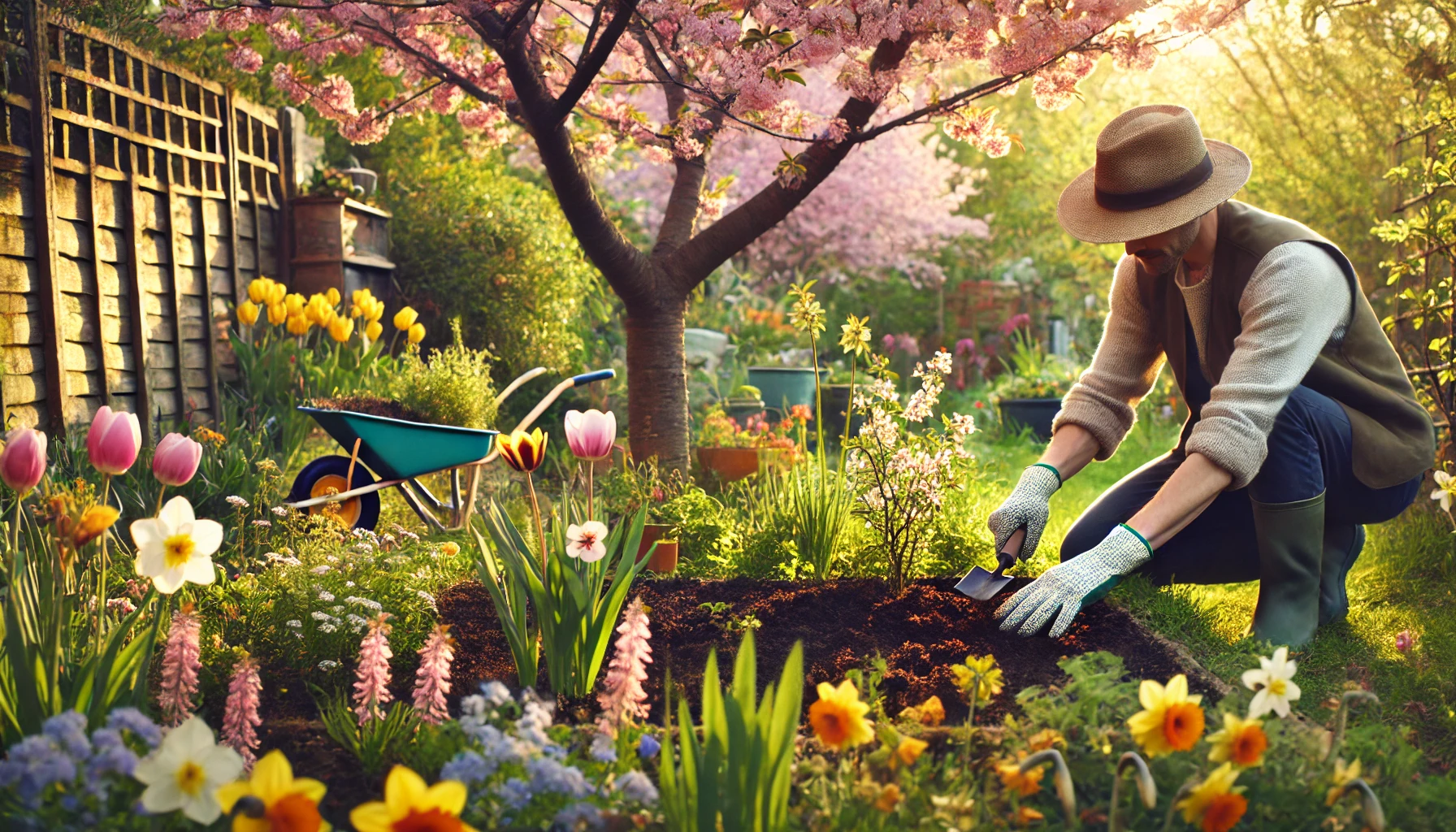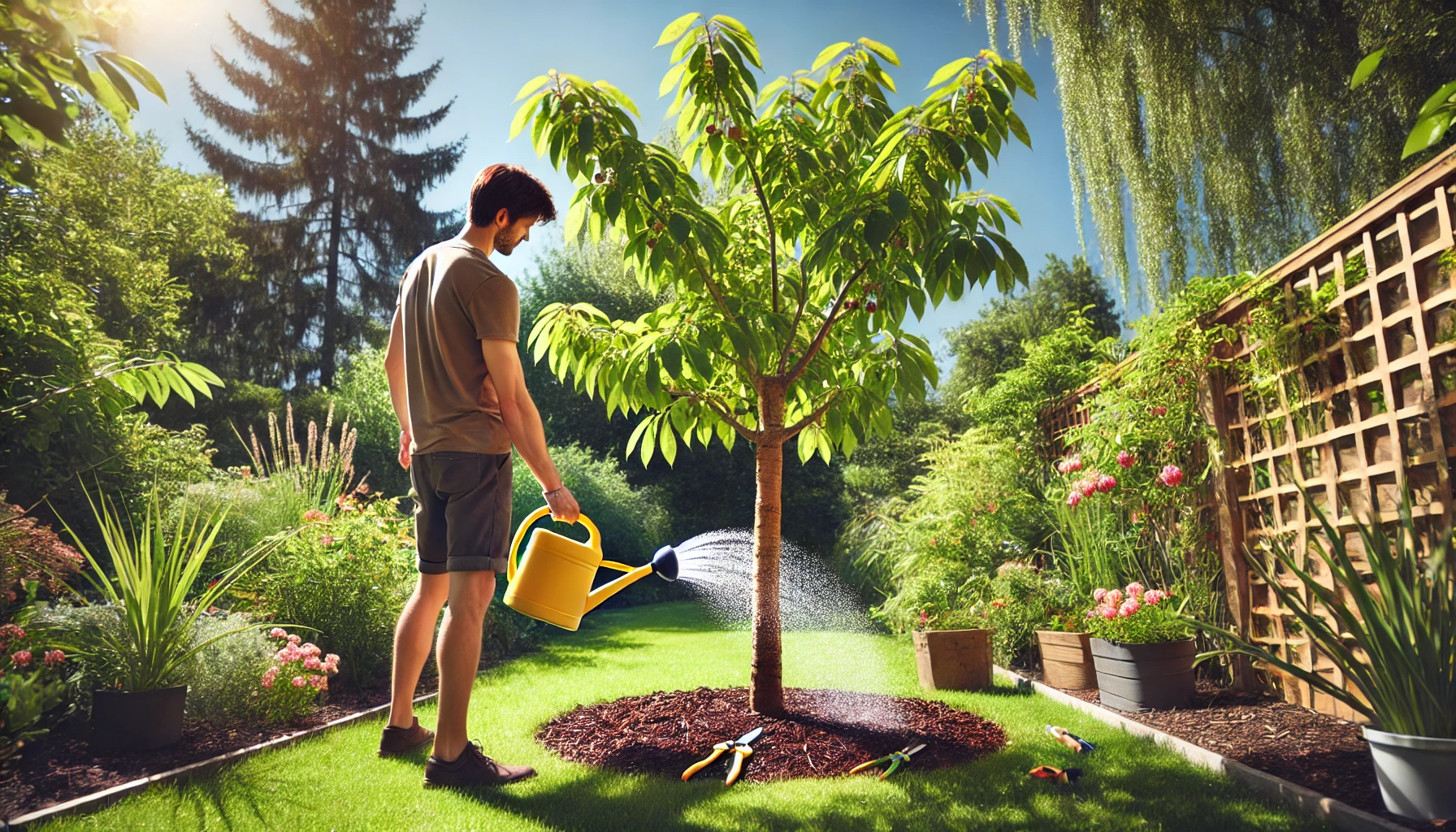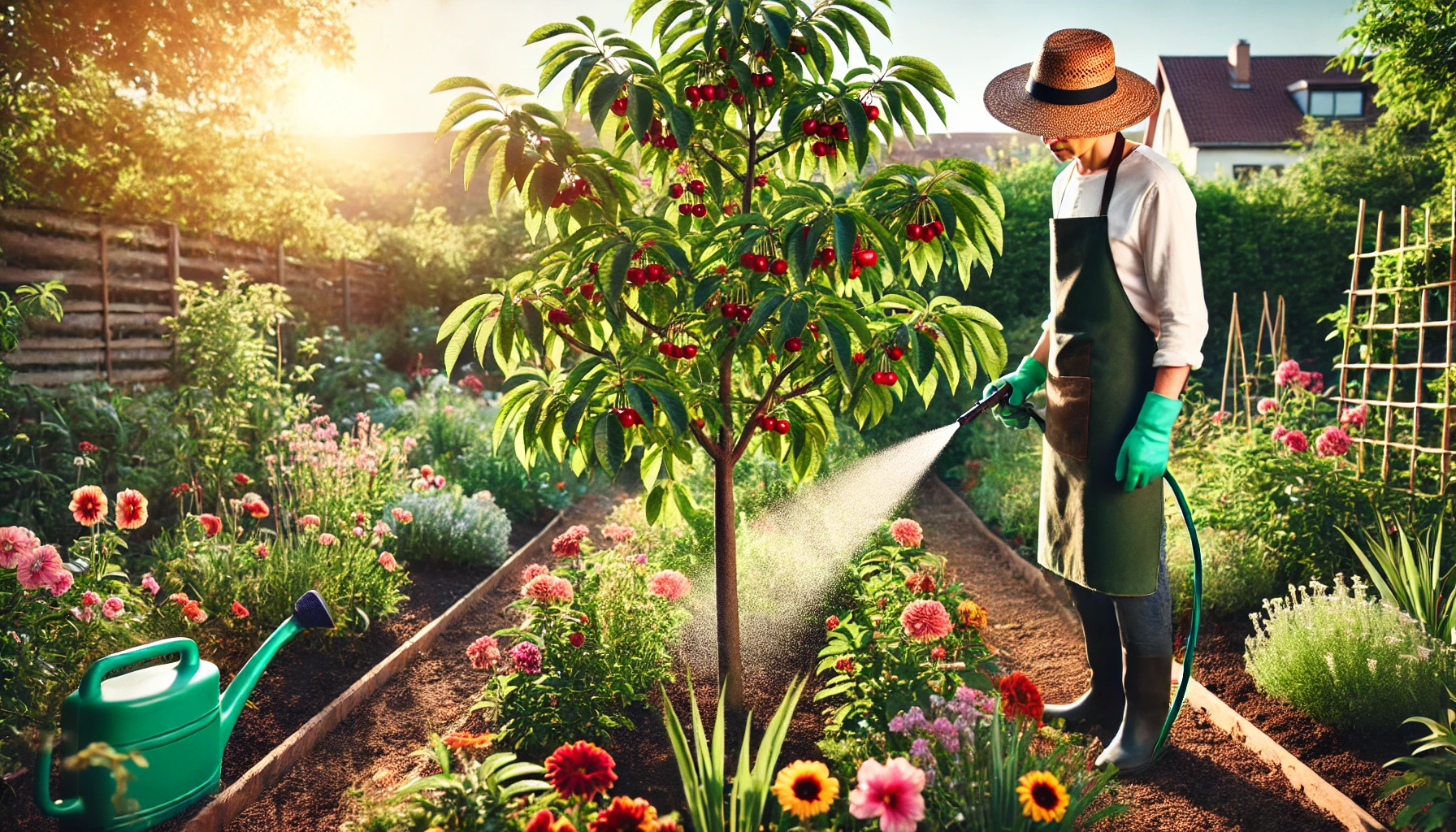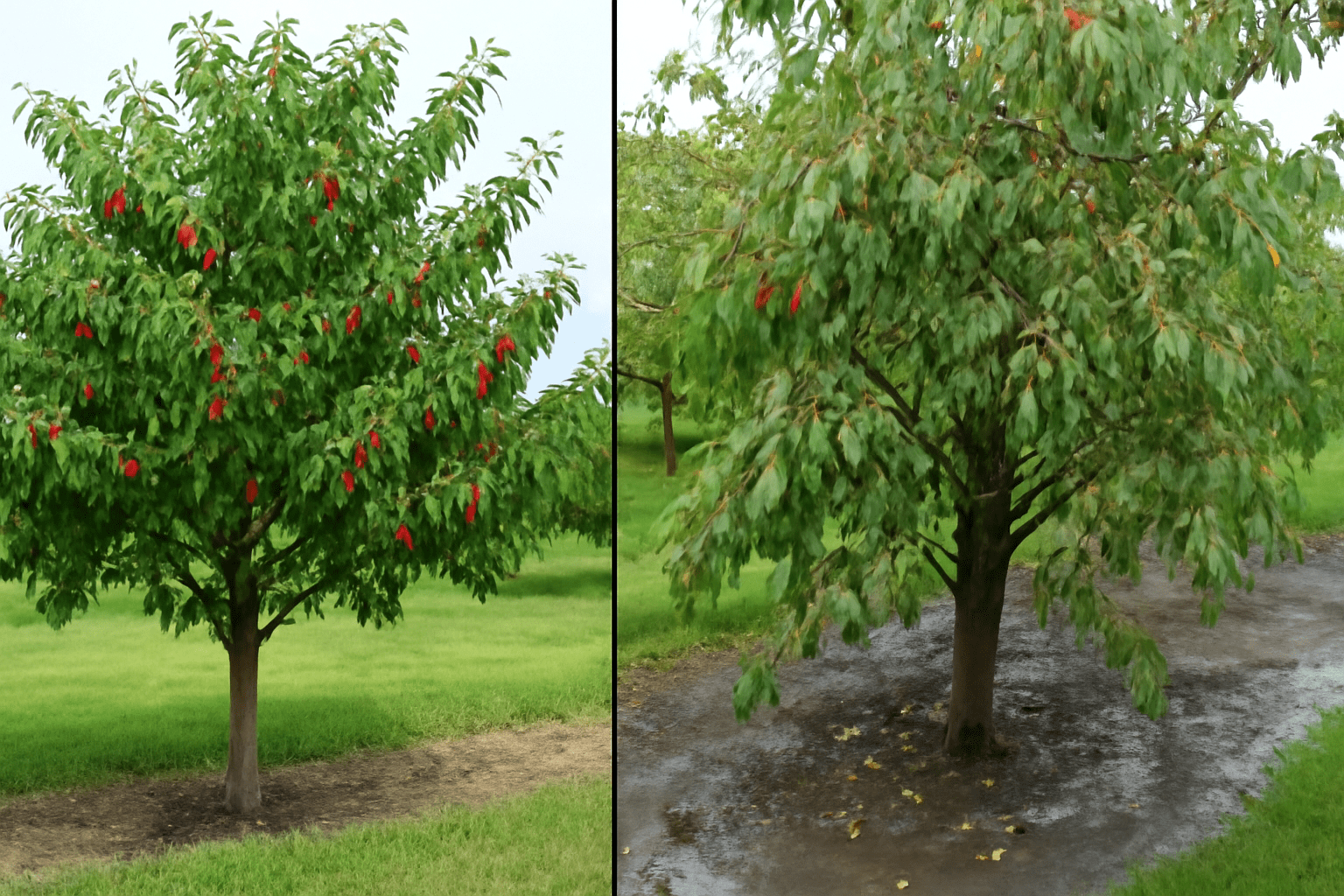
Cherry Tree Maintenance Checklist for Year-Round Health: Expert Tips
Taking care of a cherry tree requires more than just watering and occasional pruning—it’s about consistent, year-round attention to ensure it thrives through every season. If you’re looking to maximize your tree’s health and fruit production, this Cherry Tree Maintenance Checklist for Year-Round Health is your ultimate guide. From spring blossoms to winter dormancy, we’ll walk you through essential tasks that will keep your cherry tree vibrant, productive, and strong all year long. Let’s dive into the expert tips that will help you achieve the healthiest, most fruitful cherry tree in your garden!
Table of Contents
ToggleSpring: Preparing for Growth 

Spring is the season when your plants begin to wake up from their winter slumber, and it’s the perfect time to prepare them for healthy growth. Here’s how to ensure your garden thrives this season:
1. Clean Your Garden Beds 
Start by removing any dead leaves, weeds, and debris that may have accumulated over the winter. This clears the space and helps prevent pests and diseases.

2. Prune Dead or Damaged Plants 
Trim back any dead or damaged branches from trees, shrubs, and perennials. This will encourage fresh growth and improve plant shape.
3. Test and Amend Your Soil 
Check your soil’s pH and nutrient levels. Add compost or organic matter to enrich the soil, ensuring it’s nutrient-rich and well-drained.
4. Plan Your Planting 
Decide which plants you want to grow based on your climate and garden space. Start seeds indoors for early crops, or plant hardy vegetables directly in the garden.
5. Start Fertilizing 
Spring is a great time to feed your plants. Use a balanced fertilizer to give them the nutrients they need to grow strong and healthy.
6. Water Wisely 
Keep the soil moist but not soggy. Early spring rains are helpful, but make sure to water your plants if there’s a dry spell.
With these simple steps, your garden will be primed for a season of lush, vibrant growth!
Summer: Promoting Healthy Growth 

Summer is a vital time for your plants, offering the perfect opportunity for growth and vitality. To ensure they thrive, follow these expert tips for promoting healthy growth during the warmer months:
Consistent Watering
During summer, your plants need more water due to the increased heat. Ensure the soil stays moist but not waterlogged. Water deeply in the morning or late afternoon to reduce evaporation and allow roots to absorb nutrients effectively.
 Adequate Sunlight
Adequate Sunlight
Most plants love sunlight, but too much direct exposure can lead to sunburn. Ensure your plants get plenty of light, but provide some shade during the hottest part of the day, especially for more delicate varieties.
Fertilizing for Boosted Growth
Feed your plants with a balanced fertilizer every 4–6 weeks. This helps provide the necessary nutrients for robust growth. Choose a slow-release formula to give your plants a steady supply throughout the season.
Pruning and Deadheading
Keep your plants looking their best by regularly trimming dead leaves and flowers. This promotes air circulation, reduces the risk of diseases, and encourages new growth. Be sure to prune early in the season to avoid shocking your plants.
Mulching for Moisture Retention
Apply a layer of mulch around the base of your plants to retain moisture and keep the soil cool. Mulching also helps suppress weeds, reducing competition for nutrients and water.
By following these simple summer care tips, your plants will flourish and grow strong, ensuring a beautiful and healthy garden throughout the season!
Fall: Preparing for Dormancy 

As the weather cools and the days shorten, it’s time to help your plants prepare for the colder months ahead. Fall is the crucial season for getting your plants ready for dormancy, ensuring they stay healthy and strong through winter. Here’s how to make the most of this important phase:
1. Reduce Watering 
As temperatures drop, many plants slow down their growth. Overwatering can lead to root rot. Reduce watering gradually, but make sure the soil stays slightly moist. This mimics natural conditions as plants prepare for dormancy.
2. Prune and Clean 
Remove dead or yellowing leaves, spent flowers, and any damaged branches. This helps prevent disease and encourages healthier growth in the spring. Be sure to clean up any fallen debris around the base of your plants to avoid fungal issues.
3. Mulch for Protection 
Add a thick layer of mulch around the roots of plants to insulate them against the cold. Mulch helps retain moisture and regulates temperature, keeping the roots warm through the winter months.
4. Fertilize Lightly 
Plants don’t need much food in fall, but a light dose of slow-release fertilizer can give them a gentle boost without encouraging too much growth. Avoid heavy fertilizing, as this can stimulate growth that’s too soft and susceptible to frost.

5. Move Potted Plants Indoors 
For plants in pots, now is the time to bring them indoors or into a sheltered location. If that’s not possible, group pots together to shield them from frost and cover them with fabric or burlap.
6. Check for Pests 
Before the first frost, inspect your plants for pests. Fall is an ideal time to treat any infestations, as pests often seek shelter in your garden as the weather cools.
By taking these simple steps, your plants will be better prepared for dormancy, ensuring they bounce back stronger when spring arrives!
Winter: Ensuring Rest and Recovery 

As winter sets in, your plants, like the Tomatillo, need a period of rest to recharge for the next growing season. Winter isn’t just about cold temperatures—it’s about creating an environment where your plant can recover and thrive when spring arrives. Here’s how to ensure a restful winter for your Tomatillo plant:

1. Reduce Watering 
During winter, your Tomatillo will enter a semi-dormant state, requiring less water. Only water when the soil feels dry, and avoid over-watering, which could lead to root rot. Keep the soil just slightly moist—enough to prevent drying out completely.
2. Maintain the Right Temperature 
Tomatillo plants prefer temperatures between 50°F (10°C) and 60°F (16°C) during winter. If you’re growing them indoors, make sure they are away from cold drafts and keep them in a warm, but not hot, space. The right temperature helps maintain their rest period without stressing the plant.
3. Cut Back on Fertilizing 
Since the plant is not actively growing, it won’t need much fertilizer during winter. Over-fertilizing can encourage growth at the wrong time, potentially weakening the plant. Hold off on feeding until the warmer months.
4. Ensure Proper Light 
If growing indoors, ensure your Tomatillo gets enough indirect light. You can use grow lights if natural sunlight is limited. About 6-8 hours of light a day should suffice for its rest phase.
5. Pruning and Cleaning 
Winter is a great time to prune dead or damaged leaves and stems. This helps your Tomatillo stay clean and healthy, avoiding any fungal or pest issues. Clean the base of the plant to remove fallen debris that could harbor pests or diseases.
By giving your Tomatillo the right care during winter, you’re helping it to rest and recharge. When spring arrives, it’ll be ready to flourish once again!
General Maintenance Tips for Cherry Tree Health 

Proper care and maintenance are essential to keep your cherry tree thriving year after year. Here are some expert tips to ensure your tree remains healthy and productive:
1. Watering 
Cherry trees need consistent moisture, especially during dry spells. Water deeply once a week, ensuring the soil stays moist but not soggy. Avoid overwatering, as it can lead to root rot. Mulching around the base helps retain moisture.
2. Pruning 
Prune your cherry tree in late winter or early spring before new growth begins. Remove dead or diseased branches and any crossing limbs to encourage healthy airflow and prevent disease spread. Always use clean, sharp tools for precise cuts.
3. Fertilizing 
Feed your cherry tree with a balanced, slow-release fertilizer in early spring. Avoid over-fertilizing, as it can lead to excessive growth with fewer fruits. A nutrient-rich soil will support better fruiting and overall tree health.
4. Pest Control 
Regularly check for common pests like aphids, cherry maggots, or caterpillars. If you spot any, use organic insecticidal soap or neem oil to keep them under control. Healthy trees are less likely to attract pests, so focus on maintaining overall tree health.

5. Mulching 
Apply mulch around the base of the tree, but not directly against the trunk. A 2-4 inch layer helps retain moisture, suppresses weeds, and regulates soil temperature. It also adds organic matter to the soil as it decomposes.
6. Monitoring for Diseases 
Look out for signs of common cherry tree diseases such as powdery mildew or brown rot. Early detection and proper care can help prevent the spread of disease. Prune away affected branches and ensure proper air circulation around the tree.
By following these simple steps, your cherry tree will stay healthy and productive, delivering sweet fruit for years to come!
Common Mistakes to Avoid 

When growing your tomatillo plant, it’s easy to make a few mistakes along the way. To help you avoid common pitfalls, here are the most frequent errors and how to fix them:
- Overwatering
- Tomatillos thrive in well-drained soil. Overwatering can lead to root rot. Water only when the top inch of soil feels dry, and ensure your pots or garden beds have proper drainage.

- Tomatillos thrive in well-drained soil. Overwatering can lead to root rot. Water only when the top inch of soil feels dry, and ensure your pots or garden beds have proper drainage.
- Planting Too Early
- Tomatillos are sensitive to frost. Planting them before the last frost date can stunt their growth. Always wait until the soil has warmed up and frost is no longer a risk.
- Not Providing Enough Sun
- Tomatillos need at least 6–8 hours of direct sunlight daily. If they’re shaded too much, they won’t grow properly or produce fruit. Choose a sunny spot for your plant!
- Ignoring Pollination
- Tomatillo plants are self-pollinating, but they still need some help from wind or insects. Ensure your garden has plenty of pollinators to encourage fruit set.
- Crowding the Plants
- Tomatillos need space to grow. Overcrowding can reduce airflow, increase disease risk, and stunt growth. Space plants about 18–24 inches apart to ensure they have enough room.
- Using Poor Soil
- Tomatillos prefer slightly acidic, nutrient-rich soil. Avoid planting them in poor or compacted soil. Amend your soil with compost for the best results.
By avoiding these common mistakes, you’ll be on your way to growing healthy, productive tomatillo plants!
Conclusion 

Caring for your cherry tree throughout the year may seem like a lot of work, but with a consistent approach, you’ll be rewarded with a thriving, healthy tree that produces beautiful fruit season after season. By following the Cherry Tree Maintenance Checklist for Year-Round Health, you’re not just helping your tree grow—you’re fostering a strong connection with it, ensuring its longevity, and enhancing its ability to bear fruit. Remember, regular care, timely pruning, pest management, and proper watering are all crucial steps toward building a flourishing cherry tree.

Stay committed to your tree’s health, and soon enough, you’ll enjoy the fruits of your labor—literally! 
Frequently Asked Questions(FAQ)
Why is year-round maintenance important for my cherry tree?
Year-round maintenance ensures that your cherry tree remains healthy, strong, and productive. By attending to it in every season, you can prevent diseases, promote better growth, and improve fruit yield. Proper care throughout the year also strengthens the tree, making it more resilient to pests, weather, and environmental stress.
When is the best time to prune my cherry tree?
Pruning is best done in late winter or early spring when the tree is dormant. This allows for healthy, new growth during the growing season and helps avoid unnecessary stress to the tree. Be sure to remove dead, diseased, or crossing branches to improve airflow and sunlight penetration.
How often should I water my cherry tree?
Cherry trees need deep watering, especially during dry summer months. Water your tree at least once a week, ensuring the soil is moist but not waterlogged. During the rainy season or winter, reduce watering as the tree’s needs decrease.
How can I prevent pests from damaging my cherry tree?
Regularly inspect your tree for pests like aphids, mites, or fruit flies. Use organic insecticides or natural remedies such as neem oil to treat infestations. Removing fallen fruit and cleaning up debris can also reduce pest attraction.
Should I fertilize my cherry tree?
Yes! Fertilization is essential for healthy growth. Apply a balanced fertilizer in early spring when the tree begins to grow. You can also use a winter-specific fertilizer in late fall to support root health during dormancy. Avoid over-fertilizing, as this can lead to weak growth or excessive foliage.
How do I protect my cherry tree in winter?
In winter, protect your tree by wrapping its trunk to shield it from cold temperatures and pests. Mulch around the base of the tree to help maintain soil temperature and prevent frost damage. Avoid pruning during this time to prevent winter injury.
What are the signs that my cherry tree is unhealthy?
Signs of an unhealthy cherry tree include yellowing leaves, stunted growth, damaged branches, or an abundance of deadwood. If you notice these symptoms, inspect the tree closely for pests or diseases and address them promptly. An unhealthy tree may also show poor fruit production or premature fruit drop.
Can I maintain my cherry tree if I’m a beginner gardener?
Absolutely! While cherry tree maintenance does require some attention to detail, the steps outlined in the Cherry Tree Maintenance Checklist for Year-Round Health are simple and easy to follow. Just take your time, be patient, and don’t hesitate to ask for advice from local experts or gardening communities.





